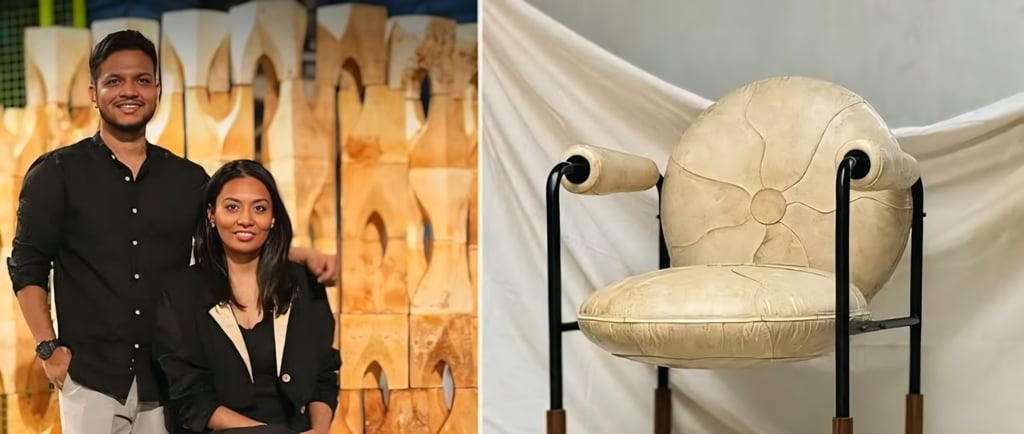Turning Mushrooms into Furniture
Growing Sofas, Not Felled Trees: How Anomalia's Bhakti & Suyash Are Changing Furniture
STARTUP TO STANDOUTSUCCESS STORYIMPOSSIBLESMART STRATEGY, MASSIVE GROWTH
Thrive Vision
10/2/20253 min read


What if your couch could grow up, live its life, and then come back into the earth—no landfill, no waste, no guilt?
In Mumbai, Bhakti Loonawat and Suyash Sawant are bringing that concept to life. With their startup Anomalia, they're transforming mushrooms into furniture utilizing mycelium (the fungal root system) and agricultural waste to create strong, aesthetically pleasing, and completely biodegradable furniture that will go back to the earth after 180 days. Their designs have captured eyeballs not only in India, but all over the world from the Venice Biennale to Seoul.
Here's their tale.
Get to know Bhakti & Suyash: Roots in Architecture, Eye on the Planet
Bhakti Loonawat and Suyash Sawant met for the first time in 2010 at an architecture school in Mumbai. They shared a common frustration: the number of wastes incurred during design, construction, and furniture manufacturing was unnecessarily large, unsustainable, and unfair.
After completing their studies in 2015, the duo parted ways for higher studies Bhakti worked under celebrated architects in Barcelona, and Suyash practiced in Lisbon. Something, however, brought them back to India. In 2022, equipped with knowledge, belief, and creative necessity, the duo started Anomalia.
Mushrooms, Mycelium, and the Magic of Waste
Their medium of choice is astounding: mycelium, the mushroom root-network. They blend it with crop and farm waste waste that would normally be incinerated or discarded—and cultivate it into blocks, panels, furniture or fabric materials. The process is time-consuming, organic, and manual. They test, shape, bake, sun-dry, and coat all so that these fungal structures are sturdy, functional, and aesthetic.
What is striking is that these items are not merely "novelties." They're made to last for everyday use. But once their time is done, they break down—giving back nutrients to the planet in some 180 days. No plastic backing to remove, no chemical pollution; just a piece of furniture that lived and then died.
From Homemade Experiments to Venice & Seoul
Anomalia began modestly. Bhakti and Suyash experimented with mushroom growth in cupcake trays during the lockdown due to COVID testing, failing, learning. As they continued to experiment, they discovered how light but firm mycelium could be. That modest start resulted in "microblocks" based on waste and mycelium weighing just 1.5 kilograms, but with the capacity to bear heavy weights.
Fast forward: the founders have showcased their work abroad. Anomalia's furniture and material design pieces have been featured at the Venice Biennale and in Seoul, where they exhibited giant facades and installations composed of their mycelium blocks. The welcome was both enthusiastic and approving it established that this sustainable path has aesthetic and functional value.
Design + Sustainability: Walking the Tightrope
One of the most difficult challenges for Bhakti and Suyash has been reconciling what customers want to purchase vs. what the earth needs. Some furniture shoppers anticipate wood, metal, or leather finishes. Mycelium furniture is new to people its texture, its color, its touch.
So Anomalia tends to mix mycelium with the known (wood planks, metal structures) to make it more accessible. They apply natural protective coatings such as beeswax or lime plaster to prevent water damage, and double-check for longevity. But they never compromise on biodegradability. Each item is made to function and then decompose.
They call their work "grown, not built" a philosophy that defies conventional furniture expectations. It's not merely about sustainable buzz. It's about closing the loop: from farm waste → furniture → soil again.
Why It Matters Now More Than Ever
The design and furniture business is ridiculously wasteful:
Trees are harvested, plastics are consumed, chemicals are used.
Furniture tends to go into landfills when styles update or materials deteriorate.
Indian crop waste is usually incinerated, leading to air pollution and health risks.
Anomalia's solution addresses two issues in one stroke: recycling farm waste (less burning and pollution) and providing furniture choices that aren't producing long-term waste. They're not doing everything perfectly but it's a significant change.
What's Next for Anomalia
They aren't done yet.
Bhakti & Suyash are in the process of scaling up production, seeking improved biotech partnerships, trying out local labs, and optimizing their process to eliminate contamination and maintain consistency. They envision it being an option for many homes, businesses, and public areas to utilize mushroom-based furniture.
They also fantasize about this: facades, interior room dividers, even buildings or pavilions utilizing this living material. Installations have already been exhibited in Seoul.
Lessons from Their Journey
Their tale instructs us much:
1. Innovation doesn't necessarily begin with money sometimes with frustration, curiosity, and home tinkerings.
2. Sustainability can be gorgeous eco-design doesn't have to sacrifice style.
3. Small steps can accumulate credibility beginning locally, with mindful scale, builds trust.
4. Materials count what we use, how we source it, and how we get rid of it determines the future.
Final Thoughts: Furniture That Grows & Gives Back
Bhakti Loonawat and Suyash Sawant aren't creating furniture. They're growing hope. They're designing with nature, not against it. In a world filled with disposable plastic and instant trends, their designs remind us that beauty, function, and responsibility can coexist.
So the next time you purchase a chair, ask: does it give back? Does it heal something, or hurt it?
Because for Anomalia, furniture is not merely something you sit on it's something that lives, breathes and comes back.
Inspiration
Explore success stories and motivational journeys today.
Growth
Vision
© 2025. All rights reserved.
